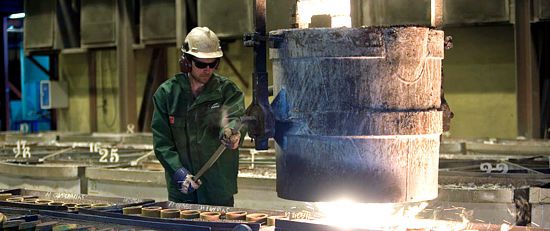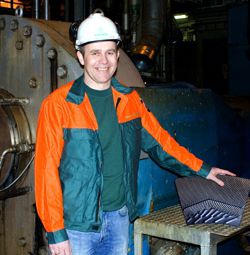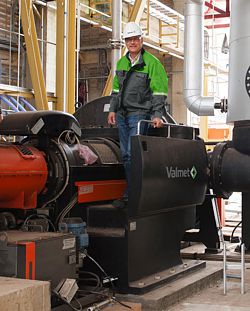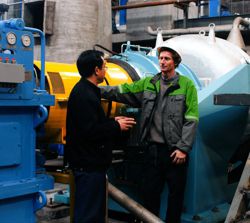Valmet Refiner Segments - there is always a higher level
Constantly testing the limits is a well-established culture among those of us who work in refiner segment technology. Our application experts and designers are always looking for a way to move to a higher level. With experience of over 2000 operational applications worldwide, our staff can always find ways to reach a higher level of performance.
How do these products and processes come about? Read on to learn about some Valmet refiner technology developments that pushed the limits...
Gentle defibration secures energy savings
A large pulp producer in Finland, operating with parallel TMP lines, reduced specific energy input per ton by more than 10% over a period of five years. As early as the 1990s, segments from Valmet such as the low energy and unidirectional features contributed to this success.
Valmet experts working with mill staff gave new life to many TMP and MDF mills faced with increasing electricity costs. The low energy feature raised the hopes of reaching higher levels.

New designs require new production technologies.
Although the Finnish customer was satisfied, Valmet application experts understood that production could be increased additionally because the process had the capacity to receive considerably more pulp. Problems arose, however, when the flow became too high. At a given volume, fiber quality decreased. It might have seemed logical at this point to optimize and stabilize the improvements already achieved. But as someone said some time ago, "problems are only solutions in disguise." And the solution Valmet experts found for this problem led to the development of the mild defibration feature. Put simply, combining low energy and mild defibration features enabled the Finns to produce even more pulp and still meet their quality objectives.
The idea was born: what would happen if we disrupted the flow without changing base geometry, a measure that would probably increase energy consumption? How, instead, could we create controlled disorder, which would distribute the flow more efficiently without cutting the fiber? We presented these ideas to mill management, and suddenly they heard us arguing beyond our own design solutions.
We have to admit that we were not sure ourselves where this would end, and if our thoughts would lead to more effective production. Testing our idea in full-scale operation was our only option. Graciously, the customer offered us one of their TMP lines to give our ideas a chance.
The staff at the Valmet manufacturing facility in Hagfors, Sweden scratched their heads when they understood what it would involve to take these ideas from concept to finished product. They had never produced segments that had to be ground flat and sharp and highly accurate while at the same time rounded. Would the mold hold? Custom made sets were produced. After two days of testing, measuring and replacing in the factory, our staff knew it was on track. The 'disruptive' zone has since been placed differently depending on flows. Mild defibration feature was developed over a period of two years to a technology that can now be implemented in many TMP processes. Increasing production by as much as 20% says it all.
Turbine feature - the art of moving forward with control
A few of our leading experts traveled to one of the M-real production plants in Finland to convince the mill to test our latest innovation – the low energy feature. We promised 15% savings and felt very confident that mill staff would welcome this message. We met a troubled, but also demanding customer: "15% savings, we won’t be happy with less than 35%!"
Their TMP process was very modern. Like all similar processes it provided excess steam led away from the primary refiners and returned to chip preheating. The mill had its own idea about how the refiner should be able to run both the fiber and steam forward instead of designing segments that led the steam backwards. Why not put the steam to good use instead?
This was a challenge to our liking. It had never been tried before. There was risk that the process would become unstable and could require designing a whole new refiner. Nonetheless, we signed a collaboration agreement because the idea had to be examined. The University of Tampere in Finland contributed with advanced calculations. A new segment solution would also mean re-designing the entire process flow. Collaboration between experts at the university and our segment experts took us to higher levels.

How does a steam turbine work? We decided to accelerate the flow, shortening the dwell time in the machine by a tenth, while reducing disc gap to about 0.2 mm. These measures were unique. How far dared we go? And how could we control it? The answers to these questions fundamentally changed TMP refining. Our greatest concern centered on the disc gap. Knowing that the refiner had to be absolutely stable with a steady flow, we understood that we had to develop a brand new advanced product. AGS (Adjustable Gap Sensor) was the result, an instrument that can measure and control the disc gap faster and with greater precision than any other gap measurement system.
Today we have answers. It took five years. A one step CD refining line can produce up to 750 tons of fiber with a very low energy input. And we recognize that we have not reached the highest level – we’ve only achieved a 55% energy savings.
Attack bar feature - an obvious idea made possible
A lot of ideas in our design department and from our application experts pop up over the years. Some are killed for practical reasons. This was almost the case with the attack bar feature. Traditionally, refiner segment design focused on maximizing running times, where the challenge was to maintain optimal refining properties as long as possible.
Often the 'best before date' for segments is short when the raw material is coarse and causes excessive wear. Plugged segment grooves contribute to suboptimal refining.

The attack bar feature is not rocket science. Tilting the bars in the segments forward means sharper and more durable refining, which should give considerably longer operating time compared with the original segments. So far, this is logical. But the question was how to cast such a segment? The attack bar feature is a combination of extensive process expertise and thorough design made possible by advanced manufacturing technology.
The challenge was to make molds for tilted bars, which would be freed and reused again and again so that consistently high quality could be guaranteed. Finishing had to be effective without great waste of material. The production team in Hagfors, Sweden, succeeded in doing what no-one else could do.
Conquering the problems of producing the attack bar feature puts Valmet at the forefront of production technology. Valmet is unique in the world and the obvious source for extending segment running times by as much as 70%.
After this breakthrough, the production system was quickly adapted so that each segment application can now be provided with the attack bar feature and is currently used in numerous fiberboard mills in the world and a large number of TMP and CTMP plants. It’s also important to note that the attack bar feature has created new life and extended time periods in refiners supplied by manufacturers other than Valmet. The concept fits both conical and flat disc refiners.
The best thing about new customers is that they often take the lead
Over the past ten years, ten new MDF mills have been taken into operation each year in China. There is a rapid development to meet the growing construction industry in the world’s largest economy.
Robina Ltd. invested in a complete plant, with Valmet equipment throughout the line – from wood handling, defribration and forming, to pressing and finishing.
But it would be presumptuous of us to say that that was what made Robina the leading MDF producer in China, with a power consumption of 140 kWh per ton. The truth behind their success is a combination of being able to handle a difficult raw material and a concentrated focus on optimization.
Fiberboard production has been surging since the early 1990s. That was when we introduced the unidirectional feature at Medite Europe in Clonmel, Ireland for the first time. The unidirectional feature revolutionized efficient economy in MDF production overnight and contributed to Medite increasing production significantly in 1993. Medite quickly became the leading producer in Europe of advanced MDF products. At the beginning of the project, energy consumption was close to 200 kWh per ton.
So how could MDF production reach an even higher level? The target at Robina was another 20 kWh per ton reduction, to 120 kWh per ton.The solution was the attack bar and unidirectional features.

The experience from the attack bar feature in many plants is that by combining a number of measures generally produces reduced energy consumption. But the Robina case was special. Reducing energy consumption by 15% from a well-functioning process is a difficult challenge.
A number of other Valmet customers with refiners from various manufacturers have experienced the same results when they replaced their segments with the attack bar feature. The effects have been immediate. An additional value is that operation time has been extended by as much as 70% without sacrificing high fiber quality.
The attack bar feature has become the standard solution in the fiberboard industry for reaching a higher level– with guaranteed results.
We’ll make you a promise: If you have what you think is an unconventional idea about how your processes can be improved, contact your Valmet representative. We’ll listen to you, and our application experts will work with you to bring your processes to even higher levels.